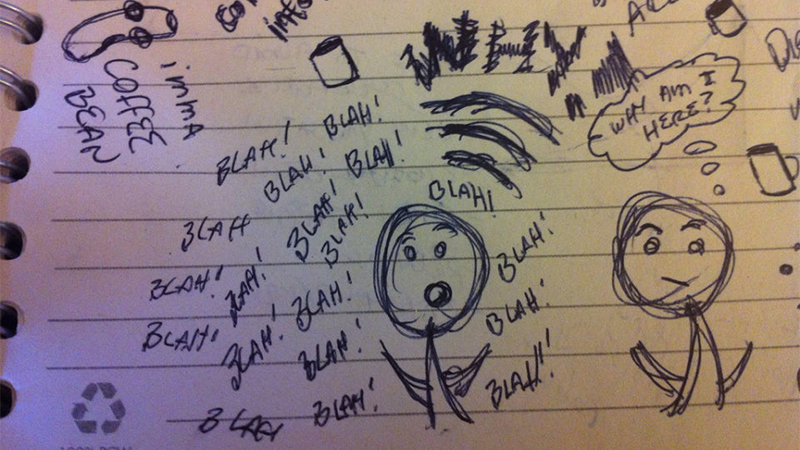How To Get The Most Out Of A Design Meeting

In the creative arena, meetings are becoming somewhat of a rarified occurrence. With increased connectivity, remote working and a predominance on digital production, the need for clients & creatives to get up-close-and-personal, is far less than say, a decade ago. But from time to time – whether a pitch, an interview or a feedback session – the design meeting is still a necessity. At best these can be productive, collaborative and inspirational, but at worse they can be a poor use of time, and damage your integrity or standing within tight-knit communities. Based on my extensive experience of great and not-so-great tête-à-têtes, here’s some useful pointers in getting the best out of a design meeting, for both creatives and clients.
1. Decide whether the meeting needs to happen
This one sounds obvious, but it isn’t. Clients need to be certain what the meeting is for, and what they want to get out of it. I was once approached to work a project, based on a high-profile project I had done prior, for a similar brief. After my successful pitch, a proposal (to which the client agreed) and much discussion a meet was scheduled. It was about half-way through the meeting, when the would-be client revealed they didn’t actually care much for my work – in particular the aforementioned, high-profile project that prompted them to contact me in the first place! It didn’t take long to establish that I probably wasn’t the designer they were after.
The lesson: do the diligence and make sure the creative (or prospective client) is someone you actually want/need to meet. If you don’t like their portfolio/website/profile from the outset, a meeting is not an effective use of time.
2. Brief every person attending the meeting
Another story: years ago I was booked for a day of freelance work for a sports agency. I was called in to meet with the creative director and a designer, who had already gone through my portfolio. Half-way through the meeting (a point I’ll cover this in the next section), the agency MD abruptly walks in, picks up my boards (yes an actual printed portfolio), and – clearly just seeing my work for the first time – curtly demands to see some ‘real brand work’ (a tremendous slight to the several brands in my then-portfolio). Safe to assume the MD hadn’t vetted my participation in the project. However a cursory glance over my work and profile prior to the meeting, may have saved us all some time (and premature greying).
The lesson: make sure everyone attending the interview knows why it is happening and what it’s for, and raise any objections beforehand.
3. If you need to see something, make sure you ask for it
Most creatives and agencies get to a point, where an abundance of work will lead to more tailored presentations and portfolios. With over 500 projects as an independent, and double that in-house/agency side, if I showed up to meetings with all of my work, ‘touching base’ would take several days. Therefore, if you’re hosting a design meeting, make sure to request what you actually want to see. Most creatives/agencies will usually ask upfront if there’s anything in particular to be discussed, at which point you can kindly ask to see a hearty selection of regional direct mail campaigns featuring unusual cats, or whatever is floating your proverbial boat.
The lesson: if you don’t ask, you don’t get
4.1 Be on time & 4.2 Show up
Design these days can seem much like a buyer’s market. There’s a sense that with an overwhelming surplus of creative types (such as myself) we’re fast becoming the business equivalent of a supermarket check-out person (and if that point causes any undue offence, please feel free to substitute with another appropriately expendable workforce example). This perception can create at best oversights, and at worst a lack of basic courtesy. Clients and creatives alike should view every design meeting as an opportunity to learn. An opportunity to see another perspective. Even if the individual/company is not right for your project or requirement, if they’ve agreed to meet you, they deserve a basic level of respect. So please – notwithstanding accidents, perilous public transport or catastrophic Acts of God – be on time. Even if you’re really, really important.
And then show up. Beyond arriving to the meeting room, this means listening, giving the other party your full attention – you may even have to put away your phone! Why does this matter? Because this is branding. Branding is more than your logo – branding is how you interface with the world, how you deal with people, and the values you extol thereof. These are things that create impressions, which in turn lead to reputations. Businesses – both creative and not – are inexorably linked in all sorts of ways, and the world is much smaller than you might think. People talk.
The lesson: treat people with the same respect you would ask for
Ultimately, please do not treat this as the meanderings of a moanful creative, but as a plea for everyone engaged in the business of design to carry themselves with a degree of conscientiousness and professionalism. And once that’s done, and the design meeting over, we can get down to the real business – doing good work.
– Greg Bunbury
Photo by justgrimes via Flickr
